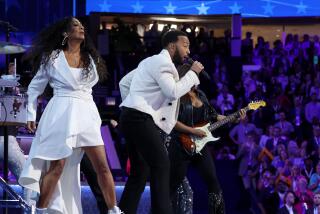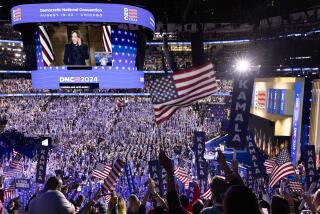The Protesters of 1960 Helped Change the World
Forty years ago--the last time Democrats met in Los Angeles to nominate a candidate for president--there was only a small possibility that front-runner John F. Kennedy would leave without his party’s nomination. This time there is not the slightest chance of uncertainty, let alone upset, in the official proceedings. The script has been written, the players rehearsed, the stage set.
But another political drama was played out in Los Angeles in 1960 that may find a reprise this week. That year, for the first time in American history, a sizable number of protesters staged demonstrations on the streets surrounding a political party convention hall. The most significant of these was a civil rights protest organized by a young Socialist of Irish Catholic background named Michael Harrington, who later wrote “The Other America: Poverty in the United States,” the book that sparked the nation’s “War on Poverty.” Harrington had worked closely since the mid-1950s with Harlem-based activists like A. Philip Randolph, president of the Brotherhood of Sleeping Car Porters, and his assistant, Bayard Rustin, in support of the emerging Southern civil rights movement.
Randolph and Rustin decided there should be a strong civil rights presence at the 1960 convention in Los Angeles, so they planned to stage a march on July 10, the day before delegates were scheduled to officially convene.
Harrington went to Los Angeles to organize the march. The work went slowly. There was no precedent for this kind of activity at a convention. Discord and doubt beset Harrington and the others working with him. At one point, Harrington called Rustin to confess failure.
“My good friend,” Rustin replied, “there is going to be a march. I know there is going to be at least one person on it. You.”
When the eve of the convention arrived, Harrington did not have to march alone. Five thousand fellow protesters--a huge turnout for that day--followed Martin Luther King Jr. and other civil rights leaders to a rally at the Sports Arena, where the Democratic National Convention was to open the next day.
Harrington and other organizers followed up the march with a round-the-clock vigil outside the Sports Arena, hoping to force the Democrats to adopt a stronger civil rights plank. Day after day during convention week, hundreds of chanting picketers kept the cause visible to the delegates and to the nation. Journalists who had come to Los Angles thinking the only story worth covering was inside the convention hall were surprised by the size and spirit of the demonstrations. The 1960 picketers thus helped rewrite the script for this and future political conventions as places where activists could bring issues of importance to public attention.
The Democrats did adopt a civil rights plank that year, although not one that Harrington, Randolph and Rustin felt went far enough.
The convention over, delegates and protesters alike dispersed. Yet the full effects of the civil rights protest at the Democratic convention were still to be felt. A month before the November election, a group of student activists in Atlanta, Ga., persuaded King to join them at a sit-in at a segregated restaurant. They were arrested for disturbing the peace, but all were soon released--except King. Georgia authorities hustled the civil rights leader off to a state penitentiary on a charge of violating probation from an earlier traffic citation.
When King was jailed, neither Kennedy nor his Republican opponent, Richard M. Nixon, initially offered any comment. Kennedy had kept the volatile issue of civil rights at arms-length ever since the Los Angeles convention; the last thing Kennedy’s staff wanted the presidential nominee to do before election day was anything that might alienate the party’s traditional base among Southern white voters.
Yet a few of Kennedy’s maverick advisors urged him to make a gesture that would, at least, show his concern for King’s safety. Finally deciding to take the risk, Kennedy telephoned King’s wife, Coretta Scott King, to offer his sympathies. Also, his brother, Bobby Kennedy, successfully pressured a Georgia judge to order King’s release.
On election day, black voters rewarded Kennedy, giving him 70% of their vote, significantly more than given to the Democratic presidential nominee in 1952 or 1956. Arguably, the black vote made the difference in Kennedy’s extremely narrow margin of victory in 1960.
Given the political risks, however, why did ultra-cautious Kennedy make the decision in October to help King against the advice of most seasoned advisors? I believe that memories of the march and picket line at the Los Angeles Democratic convention prompted him to pay attention to an issue that, before then, had little engaged him. A consummate old-school politician, Kennedy was learning to operate in a new political environment in which movements that were armed with little political clout but a strong moral claim would have an increasing say in setting the nation’s priorities.
This week, while enjoying the din of predictable acclaim within the convention hall, Al Gore would be well advised to keep one ear cocked to the hum of unpredictable discord without. As Kennedy would learn in 1960, there are times when even the most carefully rehearsed presidential candidate could do worse than throw away the script.
More to Read
Get the L.A. Times Politics newsletter
Deeply reported insights into legislation, politics and policy from Sacramento, Washington and beyond. In your inbox three times per week.
You may occasionally receive promotional content from the Los Angeles Times.










